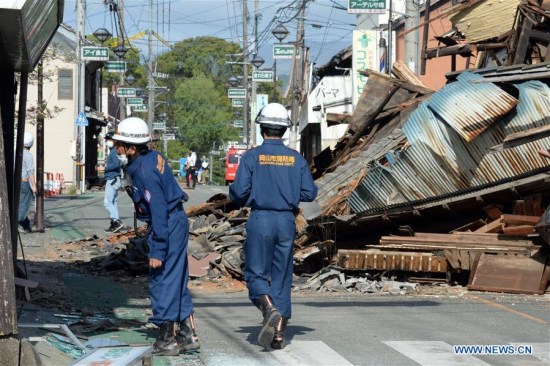
Firefighters check the buildings in the earthquake rocked Mashiki in Kumamoto prefecture, Japan, April 17, 2016. A powerful magnitude-7.3 earthquake struck the island of Kyushu in southwestern Japan early Saturday just a day after a sizable foreshock hit the region, with the number of fatalities now standing at 41 according to the latest figures on Sunday. (Xinhua/Ma Ping)
An official with the China Earthquake Networks Center (CENC) has told the public not to interpret the recent seismic activity seen in the world as creating a greater risk for China being hit.
Pan Huaiwen, director of the China Earthquake Networks Center (CENC), made the call at a press conference held by the State Council Information Office on Monday, after four above-7.0-magnitude earthquakes shook the world in eight days since April 10.
There have been 37 instances in the world where a series of earthquakes above 7.0 magnitude struck in such close succession since 1900, Pan said. Of those, only three were followed by a major quake in China.
Therefore, Pan said, this round of major quakes, statistically, has no correlation with China being subjected to greater risk.
Since 2004, earthquakes above 8.0 magnitude have been more frequent when compared to the relatively "calm period" since the 1960s. This active period will last for a while, said Jiang Haikun, a CENC forecaster.
Pan suggested that China invest greater efforts in building strong houses to withstand potential quakes. "Quakes do not kill people, poor buildings do," he said.
China is subject to earthquakes with heavy casualty and economic losses, Pan said, adding the nation should stay prepared for earthquakes in terms of seismic surveillance and disaster reduction, the most effective being strengthening buildings.
Pan recalled the 1976 earthquake in Tangshan, a 7.8-magnitude one, that killed 242,000 people, saying shabby construction due to poor economic conditions back then and low disaster-reduction awareness were to blame.
Now, as China makes great headway in economic development and catches up in disaster prevention and reduction, Pan said the country should put greater resources in strengthening buildings and other preparatory measures.
The last few days since April 10 saw a 7.5-magnitude earthquake in Ecuador, a 7.3-magnitude one in Japan, a 7.2-magnitude one in Myanmar, and a 7.1-magnitude one in Afghanistan.


















































